Using Concrete Pavers with Grass, Groundcover or Rock In-Between
If you currently have a concrete slab but want the look of large pavers with another material interspersed throughout—such as grass, artificial turf, groundcover, or river rock—you may be thinking that you need to tear out your entire concrete slab to make it happen. However, that’s not the case. Professional and licensed decorative concrete contractors such as SUNDEK can create this look with the slab you already have. “Incorporating Sundek’s Classic Texture design with, for example turf or bluestone, gives the client that extra wow factor for their pool,” says Jeff Burley of Concrete Coatings, Inc. in New Orleans. “I have always thought that our SUNDEK product is the icing on the cake, while the pool water is the roses. This design is an added rose to the project.”
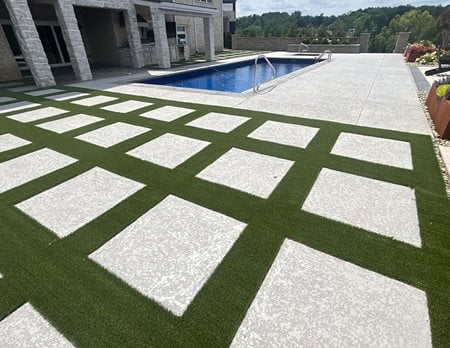 SUNDEK of Nashville coated the pavers and deck of this backyard pool area using Classic Texture.
SUNDEK of Nashville coated the pavers and deck of this backyard pool area using Classic Texture.
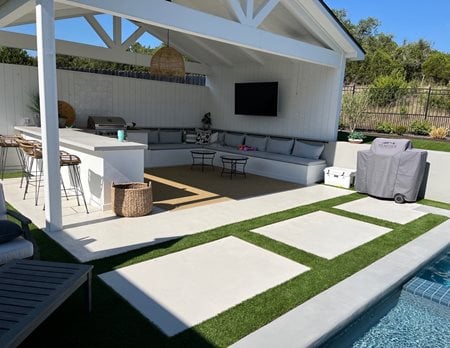 At this backyard residence in Cody, TX, SUNDEK of Austin coated this outdoor gathering space and pavers with Classic Texture smooth finish in Oyster White with Tweed Gray.
At this backyard residence in Cody, TX, SUNDEK of Austin coated this outdoor gathering space and pavers with Classic Texture smooth finish in Oyster White with Tweed Gray.
How to Get Concrete Cutouts
Cutting into concrete isn’t a simple DIY project. We highly recommend hiring an experienced concrete contractor to help you with this project because once you cut into your concrete, there’s no going back. “It is important to communicate with your concrete contractor about what product you intend to fill the new cut concrete with,” says Jeff. “The depth and width of the cut varies between each product.” Here’s the basics about getting concrete cutouts. This is not meant to be a how-to documentation. Rather, it’s meant to give you an idea of what to expect with this type of project.
- Prepare concrete by etching or grinding. Because your concrete slab is going to be cut into sections, it may be easiest to prep it for any future coatings before you cut it. Prepping it after you make your cuts will require you to grind and etch each concrete paver rather than completing the entire thing at once.
- Clean surface. Removing all dust and debris will ensure that you have a clean slate to work with, so you can easily see where your line markers need to go.
- Determine where to place your cuts and mark them. Every step is important, but this step is crucial to getting a series of pavers that look even and line up properly. You can use chalk lines or tape—whichever you or your crews prefer to work with.
- Verify your lines are accurate. After marking your lines, look at it from various angles and get a few different eyes on the project to make sure your lines are exactly where they should be. Don’t cut corners on this step, as an uneven line can make or break the look of your project.
- Cut your lines. To achieve this step, we recommend wet cutting with a diamond blade. This method will control the amount of silica dust that’s produced. Silica dust is hazardous to breathe in, so even when you use the wet cutting method, be sure you’re working in a space with adequate air flow and that all crews are wearing a well-fitted industrial respirator mask.
TIP: “If turf is being installed, make sure the coating is applied before the new turf runners are installed,” advises Jeff. “This order of operations allows for the coating to reach all edges of the slab for a cleaner look.”
What Size Gap to Include Between Slabs
Figuring out how much space to include between your concrete slabs can be challenging. When making your decision, a few factors to consider:
- Style. What look do you like? Use online resources to see your options and figure out if you like a small or larger gap.
- Drainage. Do you get a lot of rain? Make sure the pattern you choose is right for the draining requirements of your surface. This is where the expertise of a knowledgeable contractor comes in handy.
- Material. If you’re planning on using live material instead of artificial turf or rock, you need to make sure that you’re leaving enough room for the plant to establish roots in fertile soil.
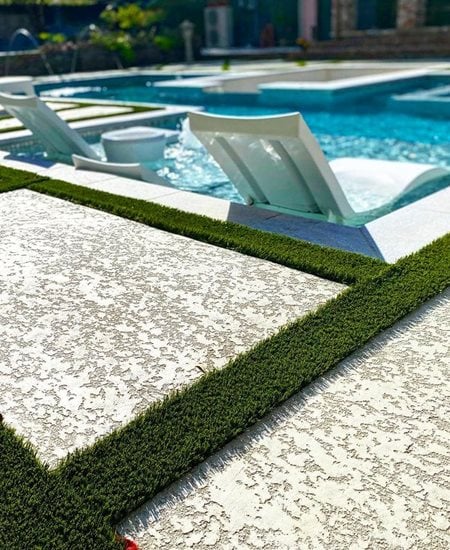 For this residential pool deck, SUNDEK partner, Concrete Coatings Inc. (CCI) in New Orleans, coated these concrete pavers with Classic Texture and placed turf in between, creating a gorgeous spot to hang out by the pool.
For this residential pool deck, SUNDEK partner, Concrete Coatings Inc. (CCI) in New Orleans, coated these concrete pavers with Classic Texture and placed turf in between, creating a gorgeous spot to hang out by the pool.
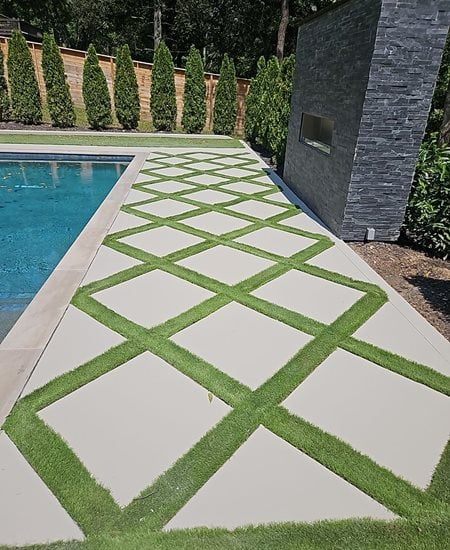 SUNDEK of Nashville created an elegant pattern for the space between the outdoor fireplace and pool, using SunRestore with a broom finish for the pavers.
SUNDEK of Nashville created an elegant pattern for the space between the outdoor fireplace and pool, using SunRestore with a broom finish for the pavers.
What Greenery to Place Between Concrete Slabs
If you plan to put greenery between your concrete pavers, you need to decide what you want to place in the gaps. You can install turf, another living material such as grass, or rock. Here, we address all options:
Installing Turf Between Concrete Pavers
While installing turf between your concrete pavers will provide you with a low-maintenance green material, you need to prepare the area properly so your turf stays in place. Here are some tips to keep in mind:
- Clean the area. Remove any debris such as loose stones, concrete pieces, or leaves from the area between pavers.
- Tamp down the dirt. Adequately tamping down the dirt and making sure it’s compact as possible will prevent your subbase (and eventually turf) from sinking. For small areas between pavers, contractors sometimes use bricks as a tamp.
- Consider using a weed-blocking material. For best results, it’s a good idea to use a weed blocker to prevent weeds from popping up and disturbing your turf.
- Use a subbase. Installing a subbase gives you a compact foundation to place your turf on top of, which makes it more stable. The subbase also helps with drainage. The two types of subbases commonly used are decomposed granite (DG) and crushed miscellaneous base (CMB).
- Make sure your subbase is the right height. Using a sample of turf, determine if your have enough subbase so that the top of your turf will be flush with the tops of your concrete pavers when everything is laid out.
- Place turf. Cut your pieces of turf to fill gaps between pavers. This step requires meticulous attention to detail so the turf fills out the spaces adequately.
Planting Live Material Between Concrete Pavers
Whether you want to include living grass or a groundcover between your concrete pavers, do your research into what you’re planting. Here are some things to keep in mind:
- Height. How tall does the grass or groundcover get? Keep in mind how often you’ll need to mow to prevent the space from looking overgrown or from tripping people walking on it.
- Water requirements. For many groundcovers, frequent watering is required. Make sure whatever you choose can be maintained so you don’t end up with brown and dry instead of green and lush interspersed with your concrete.
- Sun requirements. If your space gets shady, you’ll need something that can thrive even though it doesn’t get a lot of sun (or vice-versa).
Here are a few other popular choices for living greenery in between pavers:
- Living turf grass offers a classic look, and, when placed properly, can be mowed right over to keep a maintained look.
- Dymondia is a low-maintenance groundcover that has a silvery-green color that looks fantastic when paired with concrete.
There are many other groundcover plants to choose from, and what’s right for you depends on your space and location. Here’s a great article from Gardenista on choosing groundcovers for in between pavers.
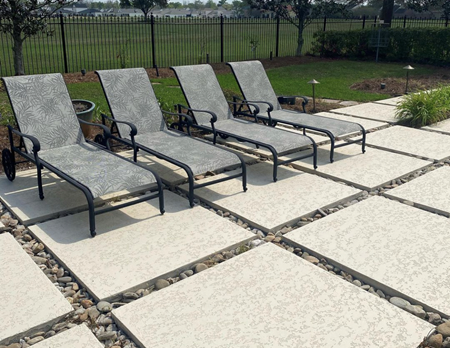 Here, CCI placed large river rock in between each concrete paver coated with Classic Texture to complete this stunning, low-maintenance poolside hangout spot.
Here, CCI placed large river rock in between each concrete paver coated with Classic Texture to complete this stunning, low-maintenance poolside hangout spot.
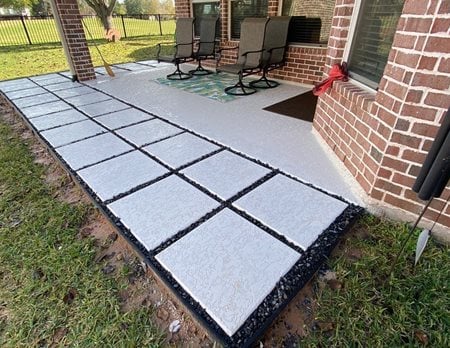 SUNDEK of Houston refinished this patio and pavers with Classic Texture in Oyster White.
SUNDEK of Houston refinished this patio and pavers with Classic Texture in Oyster White.
River Rock in Between Pavers
Placing river rock in between concrete pavers is another great option that many prefer due to their low maintenance. Similar to placing artificial turf or living material, you’ll need to do some prep work before placing the stone such as tamping down the dirt in between and including a weed barrier.
Other Popular Design Options
- Concrete That Looks Like Wood
- Scored Concrete Floors & Patios Disguise Cracks
- Exposed Aggregate Concrete: Get the Look with Resurfacing
Concrete Contractors Who Do Concrete Cut-Outs
If you’re looking for a contractor who can take your existing concrete slab and create cut-outs so you can have concrete pavers with greenery in between, find an authorized SUNDEK installer in your area.
Your Local Contractor:
Unfortunately:
We currently do not have a local installer in your area.